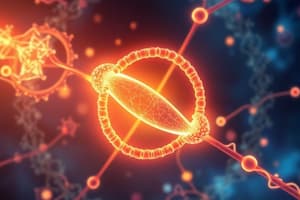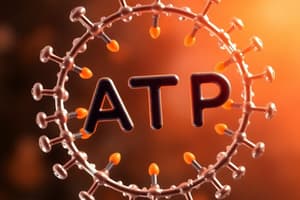Podcast
Questions and Answers
What is the primary role of ATP in cells?
What is the primary role of ATP in cells?
- To store genetic information
- To serve as an energy currency (correct)
- To transmit signals within the cell
- To regulate cell division
Which of the following correctly describes the structure of ATP?
Which of the following correctly describes the structure of ATP?
- It contains four phosphates and a nitrogenous base
- It consists of a sugar, a base, and three phosphates (correct)
- It contains two phosphates and a sugar
- It is a type of lipid
What is adenosine triphosphate primarily composed of?
What is adenosine triphosphate primarily composed of?
- Adenine, ribose, and three phosphate groups (correct)
- Carbon, hydrogen, and oxygen molecules
- Glucose and fatty acids
- Proteins and nucleic acids
In which process do plants create ATP using glucose?
In which process do plants create ATP using glucose?
Which type of respiration may occur without the use of oxygen?
Which type of respiration may occur without the use of oxygen?
Which function does ATP NOT serve in cellular processes?
Which function does ATP NOT serve in cellular processes?
Which of the following organisms do not require ATP?
Which of the following organisms do not require ATP?
What type of biomolecule is ATP associated with?
What type of biomolecule is ATP associated with?
What occurs during the hydrolysis of ATP?
What occurs during the hydrolysis of ATP?
Why is the ATP molecule considered unstable?
Why is the ATP molecule considered unstable?
What is the purpose of coupling the energy release from ATP hydrolysis with other cellular processes?
What is the purpose of coupling the energy release from ATP hydrolysis with other cellular processes?
What happens to ATP when it is hydrolyzed?
What happens to ATP when it is hydrolyzed?
In which type of transport is ATP primarily involved?
In which type of transport is ATP primarily involved?
What is meant by the phosphorylation of a protein?
What is meant by the phosphorylation of a protein?
Using the spring analogy, what does ATP represent when compressed?
Using the spring analogy, what does ATP represent when compressed?
Which of the following statements about the ATP cycle is true?
Which of the following statements about the ATP cycle is true?
Flashcards
ATP
ATP
Adenosine triphosphate; a nucleotide derivative with three phosphate groups, crucial for cellular processes.
ATP Function
ATP Function
ATP powers various cellular activities like active transport, muscle contraction, and cell signaling.
ATP Structure Parts
ATP Structure Parts
ATP comprises a nitrogenous base (adenine), a ribose sugar, and three phosphate groups.
ATP Production Methods
ATP Production Methods
Signup and view all the flashcards
Aerobic Respiration
Aerobic Respiration
Signup and view all the flashcards
Anaerobic Respiration/Fermentation
Anaerobic Respiration/Fermentation
Signup and view all the flashcards
Cellular Processes that use ATP
Cellular Processes that use ATP
Signup and view all the flashcards
ATP (Energy Currency)
ATP (Energy Currency)
Signup and view all the flashcards
ATP Cycle
ATP Cycle
Signup and view all the flashcards
Hydrolysis of ATP
Hydrolysis of ATP
Signup and view all the flashcards
ATP structure instability
ATP structure instability
Signup and view all the flashcards
Exergonic reaction
Exergonic reaction
Signup and view all the flashcards
ATP as a spring
ATP as a spring
Signup and view all the flashcards
Coupled reaction
Coupled reaction
Signup and view all the flashcards
Phosphorylation
Phosphorylation
Signup and view all the flashcards
Active transport
Active transport
Signup and view all the flashcards
Study Notes
ATP - Cellular Energy
- ATP is crucial in many cellular processes, acting as an energy currency.
- Often depicted as a starburst or thunderbolt, its significance in cellular functions is widely recognized.
- ATP is a nucleotide, similar to DNA and RNA, containing phosphate, sugar, and a base (adenine).
- It's crucial for active transport (moving substances against their concentration gradient).
- Facilitates muscle contraction (actin-myosin interaction).
- Plays a role in cell signaling and communication.
ATP Structure and Function
- ATP stands for adenosine triphosphate.
- Adenosine triphosphate has three phosphate groups, a sugar (ribose), and a nitrogenous base (adenine).
- This structure directly relates to its energy-transfer function.
- The bonds between phosphate groups are high-energy, meaning that breaking these bonds releases energy which the cell can use.
- ATP is unstable, and the negative charges of its phosphates favor their separation.
- ATP hydrolysis (the removal of a phosphate group) releases energy. This energy is used by cells for many different purposes.
- ADP (adenosine diphosphate) results when a phosphate group is removed from ATP, making ADP a crucial part of cellular respiration.
ATP Production
- Cells need various methods to create ATP.
- Aerobic cellular respiration (involving oxygen) and anaerobic respiration (without oxygen) or fermentation are examples of how ATP production occurs in various types of cells.
- Plants use photosynthesis to make glucose, which is then used during cellular respiration.
- Animals use consumed glucose for cellular respiration
- ATP is produced by all living organisms, not just plants or animals.
- ATP production is part of a continuous cycle.
ATP Cycle
- ATP can be hydrolyzed and lose a phosphate, releasing energy that the cell utilizes.
- Cellular respiration, and other energy-releasing processes, can replenish the phosphate group to turn ADP back into ATP, restarting the cycle.
- The cell continually uses and re-creates ATP to support its functions effectively.
Active Transport
- ATP powers active transport, where molecules move against their concentration gradient.
- Membrane proteins (like those involved with transporting materials) can be phosphorylated (getting a phosphate group) by ATP, changing their shape to drive molecules across the membrane.
Example Process
- ATP is essential for various biological processes, including muscle contraction, and cell division, all processes that have been illustrated in the video materials
Studying That Suits You
Use AI to generate personalized quizzes and flashcards to suit your learning preferences.
Related Documents
Description
This quiz explores ATP, the essential energy currency in cellular processes. Learn about its structure, significance in muscle contraction, active transport, and cell signaling. Test your understanding of how ATP facilitates various cellular functions.



